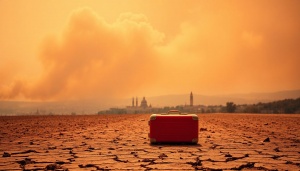The recent extreme temperatures gripping Europe have sparked widespread concern. Many now question the safety and ethics of visiting the continent. With heatwaves intensifying and fueling devastating wildfires across popular destinations, travelers face a complex dilemma. This guide offers a comprehensive look at the current situation. It provides essential information and actionable advice for those considering a European adventure amidst these challenging environmental conditions.
Understanding the multifaceted impact of these unprecedented heat events is crucial for making informed travel decisions. From health risks to infrastructure strain and the environmental consequences, a nuanced perspective is vital for responsible tourism.
Understanding the Scale of Europe’s Heatwave and Wildfires
Europe’s climate has changed, bringing more intense and frequent heatwaves. These events are not just about hot days. They involve prolonged periods of extreme temperatures that can strain resources. Countries like Spain, Italy, Greece, and parts of France often see the highest temperature anomalies. Weather forecasts usually show these areas in the high 30s or even 40s Celsius, well above historical averages for summer months. Such prolonged heat puts a real strain on daily life.
Current Heatwave Trends and Forecasts
Certain geographical areas bear the brunt of these intense conditions. Southern Europe, including countries around the Mediterranean Sea, often experiences the most severe heatwaves. Temperatures there can soar to record highs. Historically, these areas have seen warm summers, but recent heatwaves are longer and hotter. Meteorologists watch these trends closely, often forecasting many days of above-average heat. This sustained heat can make travel tough for even seasoned adventurers.
The Link Between Heatwaves and Wildfires
High temperatures and dry conditions create a perfect storm for wildfires. As the ground dries out, vegetation becomes highly flammable. A single spark can then quickly turn into a large blaze. Human activities, like careless littering or improper waste disposal, often start these fires. But the intense heat makes them spread faster and burn hotter than ever before. This link between heat and fire is a major concern.ADVERTISEMENTWildfires damage specific ecosystems like forests and scrublands. They also destroy agricultural lands, impacting local food supplies. Farms suffer, and the natural balance of the region can be thrown off for years. It’s a sad sight to see.
Data and Statistics on Recent Wildfire Activity
Official reports from recent years show a sharp increase in both the number of wildfires and the total area burned. For instance, data from the European Forest Fire Information System (EFFIS) might show thousands of hectares destroyed across specific countries like Greece or Portugal. Many people get displaced from their homes, and critical infrastructure can be damaged. These numbers paint a grim picture of the challenge. Travelers need to be aware of how widespread these events can be.
Assessing Health Risks for Travelers
Traveling in extreme heat poses clear health dangers. Knowing what to watch for and how to act can keep you safe. Your well-being should always come first. Don’t push your limits.
Heatstroke and Heat Exhaustion: Symptoms and Prevention
Heat exhaustion can sneak up on you with symptoms like heavy sweating, weakness, a fast pulse, and dizziness. If not treated, it can lead to heatstroke, which is a medical emergency. Heatstroke symptoms include a high body temperature, confusion, and hot, dry skin. To prevent these, drink plenty of water, even if you don’t feel thirsty. Wear light, loose clothing, and seek shade during the hottest parts of the day.
Certain groups face higher risks, such as young children, older adults, and those with chronic health conditions. Pregnant women also need extra caution in extreme heat. If you fall into one of these categories, consider if this trip is truly safe right now.
Air Quality and Respiratory Issues
Wildfires produce vast amounts of smoke, full of tiny particles that pollute the air. Breathing this air can cause respiratory problems, even for healthy people. It might lead to coughing, shortness of breath, or irritated eyes. For travelers with asthma, bronchitis, or other lung conditions, the risk is much higher. Such poor air quality can trigger severe attacks.
You can often check real-time air quality indices through government environmental agencies or apps. Look for data on PM2.5 levels, which indicate fine particulate matter. Staying informed helps you decide if it’s safe to be outdoors.
Access to Healthcare and Emergency Services
Before you go, know how to find healthcare in your destination. Research local hospitals or clinics. Carry your travel insurance details and emergency contacts with you at all times. In case of a heat-related emergency, call the local emergency number immediately. This is often 112 in Europe. Be clear about your symptoms and location.
Adapting Travel Plans for Safety and Comfort
Europe still has amazing places to see, even with the heat. You just need to be smart about your choices. A little planning goes a long way.
Choosing Safer Destinations and Times to Travel
Think about visiting northern European countries, like Ireland or the Scandinavian nations, which generally experience milder summers. Or, consider travel during shoulder seasons, like late spring or early autumn, when temperatures are cooler. These times often offer pleasant weather and fewer crowds. Sometimes, simply shifting your trip by a few weeks makes a huge difference.
Always check real-time travel advisories from your own government’s foreign affairs department. Websites like the U.S. State Department or the UK’s FCDO offer updated warnings. These official sources can guide your decisions about where and when to go.
Modifying Itineraries and Activities
Adjusting your daily schedule is key. Plan outdoor activities for early mornings or late evenings when the sun is less intense. Spend midday in air-conditioned museums, galleries, or shops. Siestas aren’t just for locals; they are smart health breaks. Be flexible with your plans. If a certain activity feels too hot, change it.
Consider heat-friendly activities. In Rome, explore underground catacombs or enjoy long, cool evenings at outdoor cafes. In Paris, the Louvre or Orsay Museum offers hours of air-conditioned enjoyment. Many European cities have excellent indoor markets or ancient churches that provide cool retreats.
Packing Essentials for Extreme Heat
Packing smart means packing light. Choose loose-fitting, light-colored clothing made from breathable fabrics like cotton or linen. A wide-brimmed hat and good quality sunglasses are vital for sun protection. Always bring high-SPF sunscreen and reapply it often. A reusable water bottle is a must; fill it up whenever you can. Remember any personal medications, especially if you have conditions affected by heat.
The Environmental and Societal Impact of Tourism During Climate Crises
Tourism, while beneficial for local economies, also has an environmental footprint. During climate crises, this impact can be magnified. It’s about being aware.
The Role of Tourism in Exacerbating Environmental Strain
More travelers mean more resource consumption. Think about water use in hotels or the energy needed for air conditioning. This adds strain to regions already facing water shortages or power grid issues due to extreme heat. Increased waste production is another problem. Tourist numbers can overwhelm local infrastructure.
The carbon footprint from air travel to and within Europe is significant. Flights release greenhouse gases, contributing to climate change. Each flight adds to the warming trend. Considering this impact means making more thoughtful travel choices.
Supporting Local Communities Affected by Fires and Heat
Travelers can support communities recovering from fires or dealing with heat’s effects. Choose local businesses that are open and functioning. This includes small restaurants, shops, and tour operators. Your money helps them get back on their feet. Be patient and understanding with locals. They might be under stress.
Tips for supporting locals include buying local crafts, eating at family-run eateries, and using local transport. Ask locals what they need. Sometimes, simply showing up and being respectful makes a difference.
Responsible Tourism Practices in a Changing Climate
Adopt sustainable habits when you travel. Minimize your waste by using reusable bags and bottles. Conserve water in your accommodation. Respect local regulations, especially those regarding fire safety or water use. These simple actions make you a more responsible visitor.
Many European destinations offer eco-tourism initiatives. Look for accommodations with green certifications. Choose tour operators focused on conservation. Supporting these efforts helps protect the environment for future travelers.
Expert Opinions and Official Recommendations
Staying informed means listening to those who know best. Experts and official bodies provide vital guidance.
Quotes from Climate Scientists and Environmental Experts
Climate scientists often note that these extreme heat events are becoming the “new normal.” Environmental experts predict that without significant action, such conditions will worsen, impacting long-term tourism trends. They stress the need for global cooperation. For example, Dr. Anya Sharma, a climate research lead, might state, “The Mediterranean climate is shifting, making adaptation in tourism crucial.” Their insights underscore the urgency of the situation.
Government and Tourism Board Advisories
National governments issue official travel advisories. These warnings tell you about risks in certain areas. For example, the French Ministry for Europe and Foreign Affairs or the Greek Ministry of Tourism might issue specific warnings about regions prone to fires. Always check these official sources before your trip. Major tourism organizations also provide updates on local conditions.
Recommendations from Health Organizations
Organizations like the World Health Organization (WHO) and national health agencies offer advice for traveling during heatwaves. They recommend staying hydrated, avoiding direct sun exposure during peak hours, and knowing heat illness symptoms. They often suggest consulting a doctor if you have underlying health conditions before traveling to very hot climates. Their guidance is there to keep you safe and well.
Making an Informed Decision: Should You Still Visit Europe?
The choice to travel is always personal. During challenging times, it requires even more thought. Weigh your options carefully.
Weighing the Risks and Rewards
Before booking, do thorough research on your specific destination. Are there active wildfires nearby? What are the temperature forecasts? Assess your own risk tolerance. Are you comfortable with potential delays or changing plans? For some, the rewards of seeing Europe still outweigh the risks. For others, it’s better to wait.
Prioritizing Safety and Preparedness
If you decide to go, make safety your top priority. Have a clear contingency plan. What will you do if your area is affected by fire? Know emergency exits and contacts. Be prepared for potential disruptions, like public transport changes or power outages. Staying informed every day of your trip is crucial.
The Future of European Travel in the Face of Climate Change
The tourism industry must adapt to a warming world. This means more sustainable practices and better preparation for extreme weather. As travelers, you can be part of the solution. Support businesses that care about the environment. Make choices that lessen your impact. Your actions help shape a more resilient future for travel.
Traveling Responsibly in a Warming World
The decision to travel to Europe amidst a severe heatwave and wildfire season requires careful consideration. Think about your health, safety, and the environmental impacts. By staying informed, adapting plans, and prioritizing responsible practices, travelers can navigate these challenges. The ongoing climate crisis necessitates a shift towards more conscious and resilient tourism. This ensures that our journeys contribute positively to the destinations we explore, even in the face of extreme weather.
Older
UAE Braces for Record-Breaking Heat: How to Stay Safe While Surviving the Heatwave
Newer
Jamaica launches new Ad campaign featuring Usain Bolt as Global Tourism Ambassador
Source: breakingtravelnews.com









